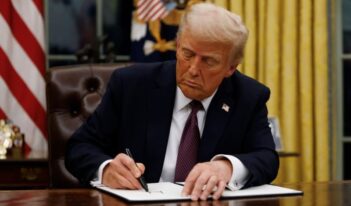
Scholar argues that the Trump Administration has discredited cost-benefit analysis.
As the United States slogs through year three of a deregulatory implosion, one truth has become clear: As practiced by the Trump Administration, cost-benefit analysis has become a perversion of a neutral approach to policymaking.
To be forthright, I was never a fan of the number crunching. I thought it created the false impression that numerical estimates were precise, drastically understated benefits, buried controversial value judgments behind barricades of formulas, and depended on unreliable indicators of how much real people valued risk. But I understood it was here to stay when Cass Sunstein persuaded President Barack Obama to embrace it. The task for people like me became understanding how the methodology was practiced by economists so that we could make arguments critiquing its harsh applications.
The first sign of a crumbling structure was the shift among congressional conservatives and their allies in the business community to an exclusive focus on costs without any mention of benefits. They talked as if the society had decided to take huge bundles of money and set them on fire for no good reason. The other troubling sign on the cost side was that many economists maintained their extreme disinterest in revising technology-forcing regulatory costs downward after a market was jumpstarted and prices for remedies fell. A classic example is the overstatement of estimated versus actual costs that were incurred by electric utilities in complying with the Obama mercury and air toxics rule and the Trump Administration’s refusal to correct its figures accordingly.
Things got worse. Even before President Trump was elected, agency economists stuck with the frail assurance that, if it would take too much effort to quantify benefits, they could describe them qualitatively and policymakers would still pay attention. For example, if a health effect was correctable with medicine, perhaps we did not need to quantify it. In the case of disrupted ecosystems, if the prize was not a fish you could plop on your dinner plate, a narrative was in order. Surprise, surprise, as a seasoned manager might advise: What gets counted gets done, and what is not counted falls off the table.
And then we arrived in the Trump era. Interesting research by Dan Farber shows that when the U.S. Congress identified 28 rules for repeal under the Congressional Review Act (CRA), and then proceeded to disapprove 11, cost-benefit analysis played no discernible role. The rules were not even the most expensive ones floating around at the time.
At some point, the congressional leadership got tired of the CRA process and moved on, leaving the Trump Administration to deliver for the business community. Defeats in court taught the lesson that, to hold, rollbacks had to be better supported, and so cost-benefit analyses for weakening or eliminating rules were prepared.
But these were not your mother’s cost-benefit analyses.
Two of the most important deregulatory initiatives crunched numbers in bizarre ways, while the industrial sectors that in theory would benefit the most from the changes begged the Administration to back off its deregulatory zeal.
The first involved fuel efficiency and greenhouse gas emissions standards for new cars and light trucks. Reportedly in response to lobbying by Marathon Oil and Americans for Prosperity, which is funded by the Koch brothers, the Trump Environmental Protection Agency (EPA) weakened the standards to such an extent that California announced it would proceed with its own rules, a prerogative granted for the last several decades under the Clean Air Act. The carmakers sent President Trump a desperate letter explaining that extended litigation between the United States and California, much less the establishment of two distinct sets of standards, would be “untenable.”
Whoever cranked out the cost-benefit numbers for the new rules came to the astonishing conclusion: Weaker standards would save 12,700 lives or, in other words, the Obama rules would have resulted in that many deaths. The claim had something to do with the idea that cars and trucks would be so much more expensive that people would drive their old, unsafe ones longer. Writing in Science last December, 11 scientists and technical experts explained that the Trump number crunchers had mysteriously lost six million vehicles by making the erroneous assumption that if weaker rules went into effect and prices fell, people would buy fewer cars and trucks. Once the six million are added back into the analysis, the benefits of the rollback shrink to zero.
The second CBA boomerang involved the Mercury and Air Toxics Standards that required the installation of scrubbers on the smokestacks of power plants and primarily targeted coal-fired units. Most utilities have finished putting up the equipment and are only paying for operation and maintenance costs. At the behest of the coal industry, the seven-year-old rule landed on the chopping block even as utility executives rushed to the White House to urge it be left alone.
Enter cost-benefit analysis. The Obama EPA said the rule would cost $33 to $81 billion (actual costs were at the lower end) and yield annual benefits of $37 to $90 billion. The bulk of the benefits figure is due to reductions in fine particulate matter that would not otherwise occur without the installation of the scrubbers required by the rule. But, said the Trump Administration, we should not count that number. All we should care about are the drastically understated benefits of reducing mercury and a few other air toxics, a paltry $4 to $6 million in all. To be sure, this change has been applied only to the threshold finding that it is “appropriate and necessary” to regulate power plants, and the Trump people say they may not take it further. The promise is not all that reassuring.
As pointed out by the Institute for Policy Integrity, refusing to count ancillary benefits while insisting on counting ancillary costs does not make a lot of sense. The benefits are real and they would not occur without regulation. Taking this excellent point one step further: How can a rational methodology for making the best possible policy tolerate such asymmetry?
If this tool, which was always more susceptible to manipulation than its proponents acknowledged, is to survive over the long run, a correction now is surely needed.




